Wheat Crop Report: Cultivation, Farming Methods, and Impact
VerifiedAdded on 2022/11/30
|6
|1454
|148
Report
AI Summary
This report provides a comprehensive overview of wheat cultivation, focusing on its global distribution, with specific attention to Australia. It details the environmental factors crucial for wheat growth, including soil type, rainfall, and temperature, supported by maps illustrating growing regions. The report explores various farming methods, such as dibbling, broadcasting, zero tillage, drilling, and the behind local plough method, with a detailed analysis of the chosen 'behind local plough' technique, highlighting its advantages and disadvantages. Furthermore, the report investigates the environmental impacts of wheat farming, including greenhouse gas emissions from fertilizers, land clearing, and potential soil degradation. It also discusses how the environment influences farming practices, emphasizing the importance of fertile soils, adequate rainfall, and suitable temperatures for optimal wheat production. The report concludes by referencing relevant scholarly articles and research papers.
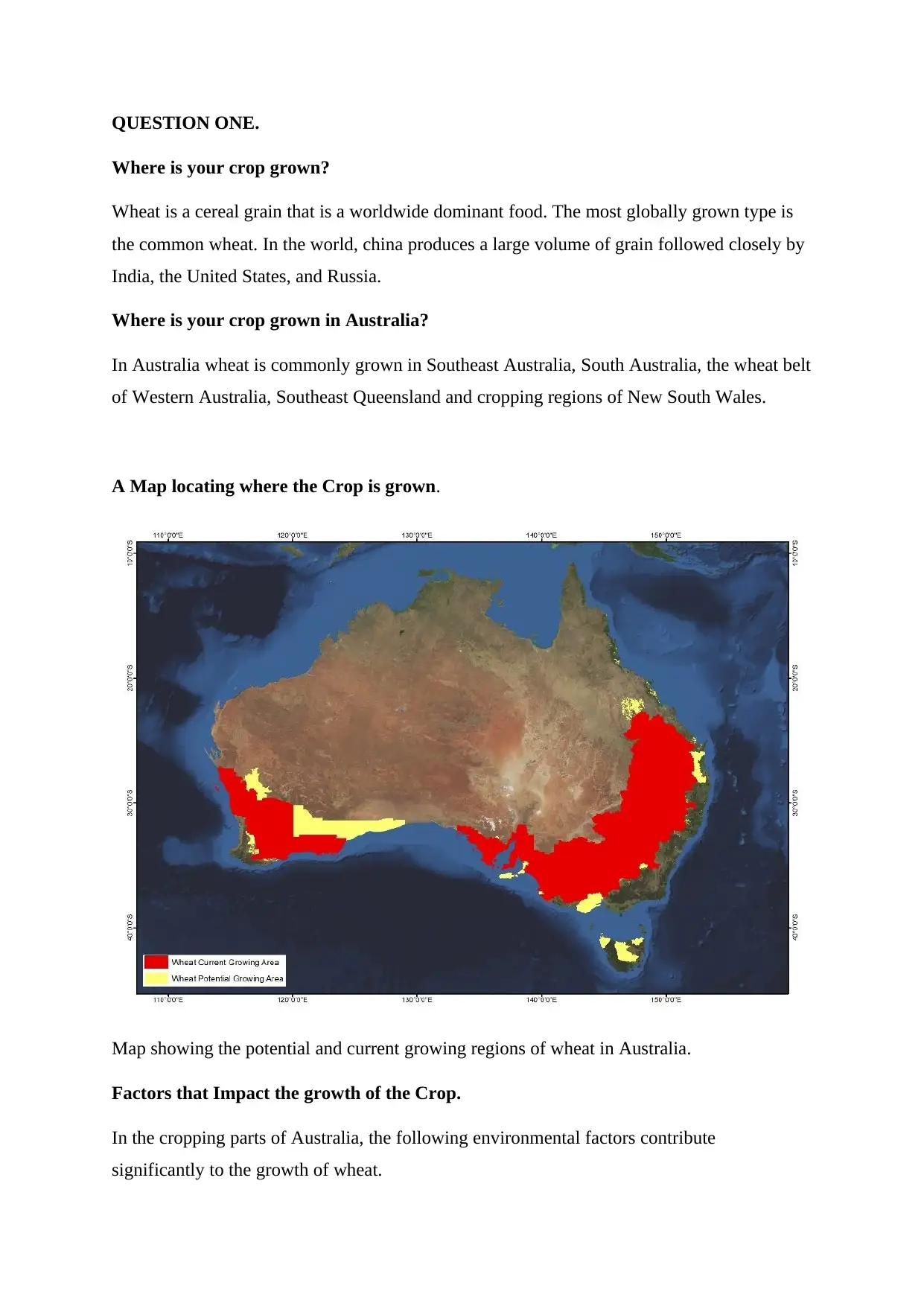
QUESTION ONE.
Where is your crop grown?
Wheat is a cereal grain that is a worldwide dominant food. The most globally grown type is
the common wheat. In the world, china produces a large volume of grain followed closely by
India, the United States, and Russia.
Where is your crop grown in Australia?
In Australia wheat is commonly grown in Southeast Australia, South Australia, the wheat belt
of Western Australia, Southeast Queensland and cropping regions of New South Wales.
A Map locating where the Crop is grown.
Map showing the potential and current growing regions of wheat in Australia.
Factors that Impact the growth of the Crop.
In the cropping parts of Australia, the following environmental factors contribute
significantly to the growth of wheat.
Where is your crop grown?
Wheat is a cereal grain that is a worldwide dominant food. The most globally grown type is
the common wheat. In the world, china produces a large volume of grain followed closely by
India, the United States, and Russia.
Where is your crop grown in Australia?
In Australia wheat is commonly grown in Southeast Australia, South Australia, the wheat belt
of Western Australia, Southeast Queensland and cropping regions of New South Wales.
A Map locating where the Crop is grown.
Map showing the potential and current growing regions of wheat in Australia.
Factors that Impact the growth of the Crop.
In the cropping parts of Australia, the following environmental factors contribute
significantly to the growth of wheat.
Paraphrase This Document
Need a fresh take? Get an instant paraphrase of this document with our AI Paraphraser
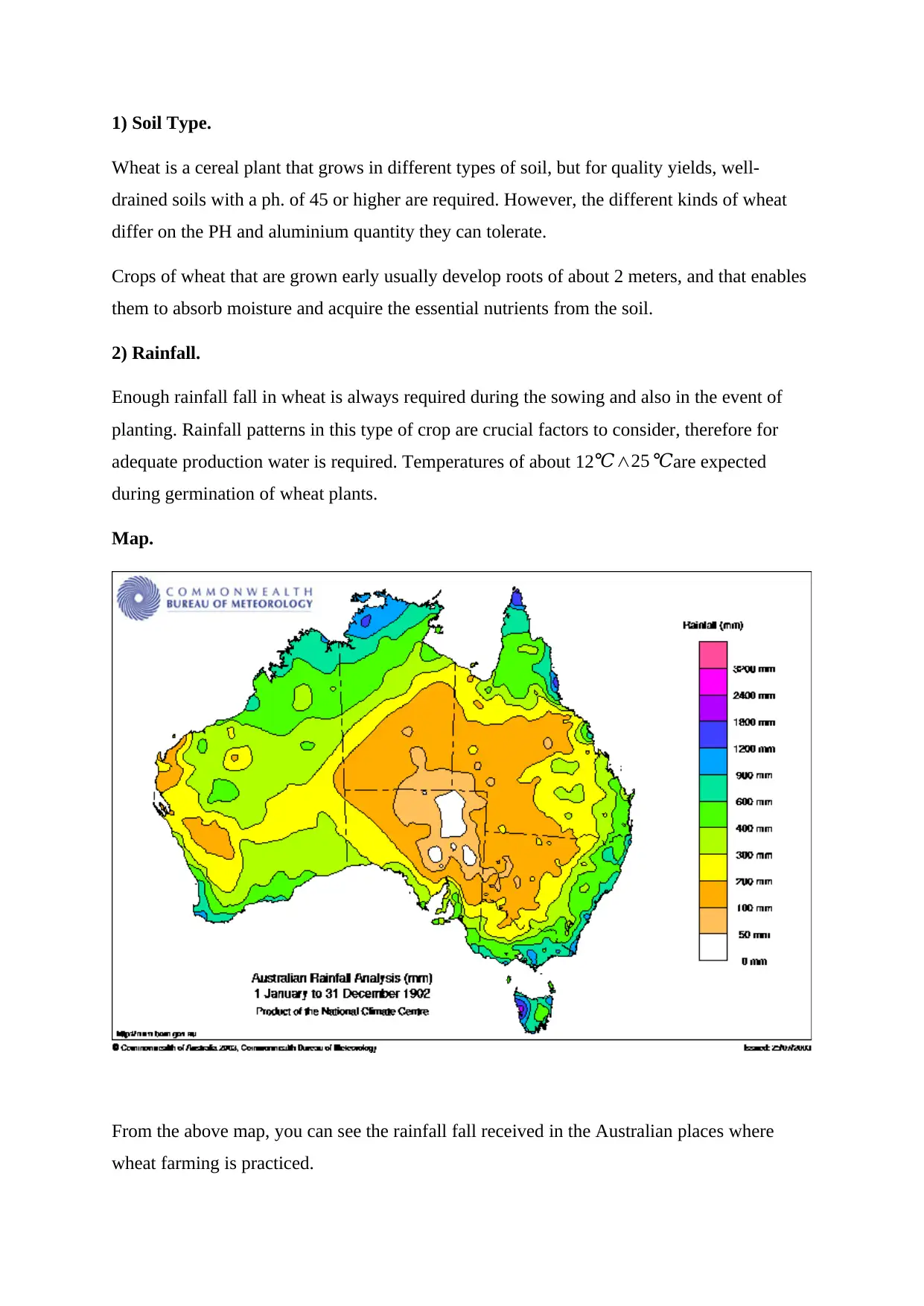
1) Soil Type.
Wheat is a cereal plant that grows in different types of soil, but for quality yields, well-
drained soils with a ph. of 45 or higher are required. However, the different kinds of wheat
differ on the PH and aluminium quantity they can tolerate.
Crops of wheat that are grown early usually develop roots of about 2 meters, and that enables
them to absorb moisture and acquire the essential nutrients from the soil.
2) Rainfall.
Enough rainfall fall in wheat is always required during the sowing and also in the event of
planting. Rainfall patterns in this type of crop are crucial factors to consider, therefore for
adequate production water is required. Temperatures of about 12℃∧25 ℃are expected
during germination of wheat plants.
Map.
From the above map, you can see the rainfall fall received in the Australian places where
wheat farming is practiced.
Wheat is a cereal plant that grows in different types of soil, but for quality yields, well-
drained soils with a ph. of 45 or higher are required. However, the different kinds of wheat
differ on the PH and aluminium quantity they can tolerate.
Crops of wheat that are grown early usually develop roots of about 2 meters, and that enables
them to absorb moisture and acquire the essential nutrients from the soil.
2) Rainfall.
Enough rainfall fall in wheat is always required during the sowing and also in the event of
planting. Rainfall patterns in this type of crop are crucial factors to consider, therefore for
adequate production water is required. Temperatures of about 12℃∧25 ℃are expected
during germination of wheat plants.
Map.
From the above map, you can see the rainfall fall received in the Australian places where
wheat farming is practiced.
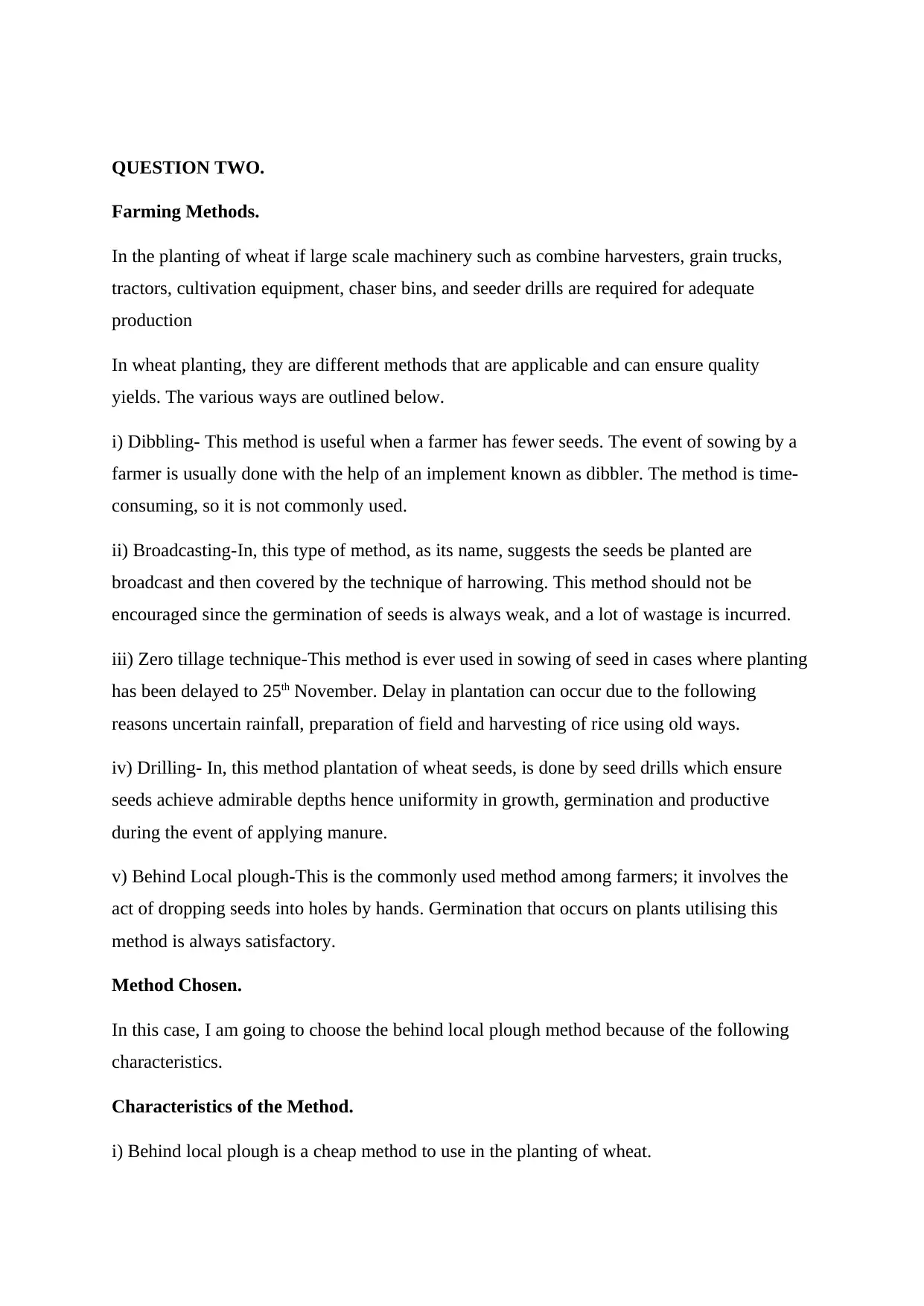
QUESTION TWO.
Farming Methods.
In the planting of wheat if large scale machinery such as combine harvesters, grain trucks,
tractors, cultivation equipment, chaser bins, and seeder drills are required for adequate
production
In wheat planting, they are different methods that are applicable and can ensure quality
yields. The various ways are outlined below.
i) Dibbling- This method is useful when a farmer has fewer seeds. The event of sowing by a
farmer is usually done with the help of an implement known as dibbler. The method is time-
consuming, so it is not commonly used.
ii) Broadcasting-In, this type of method, as its name, suggests the seeds be planted are
broadcast and then covered by the technique of harrowing. This method should not be
encouraged since the germination of seeds is always weak, and a lot of wastage is incurred.
iii) Zero tillage technique-This method is ever used in sowing of seed in cases where planting
has been delayed to 25th November. Delay in plantation can occur due to the following
reasons uncertain rainfall, preparation of field and harvesting of rice using old ways.
iv) Drilling- In, this method plantation of wheat seeds, is done by seed drills which ensure
seeds achieve admirable depths hence uniformity in growth, germination and productive
during the event of applying manure.
v) Behind Local plough-This is the commonly used method among farmers; it involves the
act of dropping seeds into holes by hands. Germination that occurs on plants utilising this
method is always satisfactory.
Method Chosen.
In this case, I am going to choose the behind local plough method because of the following
characteristics.
Characteristics of the Method.
i) Behind local plough is a cheap method to use in the planting of wheat.
Farming Methods.
In the planting of wheat if large scale machinery such as combine harvesters, grain trucks,
tractors, cultivation equipment, chaser bins, and seeder drills are required for adequate
production
In wheat planting, they are different methods that are applicable and can ensure quality
yields. The various ways are outlined below.
i) Dibbling- This method is useful when a farmer has fewer seeds. The event of sowing by a
farmer is usually done with the help of an implement known as dibbler. The method is time-
consuming, so it is not commonly used.
ii) Broadcasting-In, this type of method, as its name, suggests the seeds be planted are
broadcast and then covered by the technique of harrowing. This method should not be
encouraged since the germination of seeds is always weak, and a lot of wastage is incurred.
iii) Zero tillage technique-This method is ever used in sowing of seed in cases where planting
has been delayed to 25th November. Delay in plantation can occur due to the following
reasons uncertain rainfall, preparation of field and harvesting of rice using old ways.
iv) Drilling- In, this method plantation of wheat seeds, is done by seed drills which ensure
seeds achieve admirable depths hence uniformity in growth, germination and productive
during the event of applying manure.
v) Behind Local plough-This is the commonly used method among farmers; it involves the
act of dropping seeds into holes by hands. Germination that occurs on plants utilising this
method is always satisfactory.
Method Chosen.
In this case, I am going to choose the behind local plough method because of the following
characteristics.
Characteristics of the Method.
i) Behind local plough is a cheap method to use in the planting of wheat.
⊘ This is a preview!⊘
Do you want full access?
Subscribe today to unlock all pages.

Trusted by 1+ million students worldwide
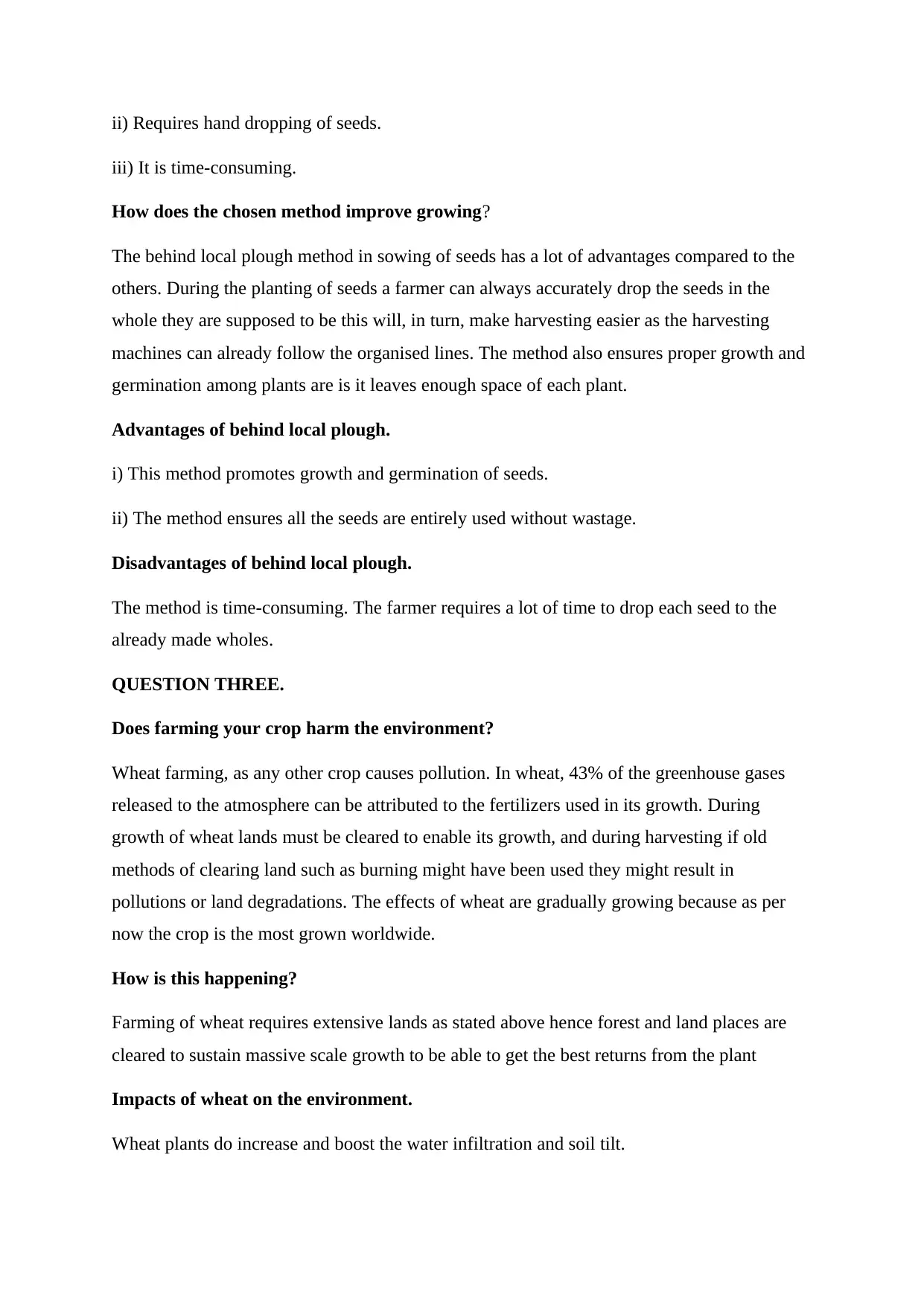
ii) Requires hand dropping of seeds.
iii) It is time-consuming.
How does the chosen method improve growing?
The behind local plough method in sowing of seeds has a lot of advantages compared to the
others. During the planting of seeds a farmer can always accurately drop the seeds in the
whole they are supposed to be this will, in turn, make harvesting easier as the harvesting
machines can already follow the organised lines. The method also ensures proper growth and
germination among plants are is it leaves enough space of each plant.
Advantages of behind local plough.
i) This method promotes growth and germination of seeds.
ii) The method ensures all the seeds are entirely used without wastage.
Disadvantages of behind local plough.
The method is time-consuming. The farmer requires a lot of time to drop each seed to the
already made wholes.
QUESTION THREE.
Does farming your crop harm the environment?
Wheat farming, as any other crop causes pollution. In wheat, 43% of the greenhouse gases
released to the atmosphere can be attributed to the fertilizers used in its growth. During
growth of wheat lands must be cleared to enable its growth, and during harvesting if old
methods of clearing land such as burning might have been used they might result in
pollutions or land degradations. The effects of wheat are gradually growing because as per
now the crop is the most grown worldwide.
How is this happening?
Farming of wheat requires extensive lands as stated above hence forest and land places are
cleared to sustain massive scale growth to be able to get the best returns from the plant
Impacts of wheat on the environment.
Wheat plants do increase and boost the water infiltration and soil tilt.
iii) It is time-consuming.
How does the chosen method improve growing?
The behind local plough method in sowing of seeds has a lot of advantages compared to the
others. During the planting of seeds a farmer can always accurately drop the seeds in the
whole they are supposed to be this will, in turn, make harvesting easier as the harvesting
machines can already follow the organised lines. The method also ensures proper growth and
germination among plants are is it leaves enough space of each plant.
Advantages of behind local plough.
i) This method promotes growth and germination of seeds.
ii) The method ensures all the seeds are entirely used without wastage.
Disadvantages of behind local plough.
The method is time-consuming. The farmer requires a lot of time to drop each seed to the
already made wholes.
QUESTION THREE.
Does farming your crop harm the environment?
Wheat farming, as any other crop causes pollution. In wheat, 43% of the greenhouse gases
released to the atmosphere can be attributed to the fertilizers used in its growth. During
growth of wheat lands must be cleared to enable its growth, and during harvesting if old
methods of clearing land such as burning might have been used they might result in
pollutions or land degradations. The effects of wheat are gradually growing because as per
now the crop is the most grown worldwide.
How is this happening?
Farming of wheat requires extensive lands as stated above hence forest and land places are
cleared to sustain massive scale growth to be able to get the best returns from the plant
Impacts of wheat on the environment.
Wheat plants do increase and boost the water infiltration and soil tilt.
Paraphrase This Document
Need a fresh take? Get an instant paraphrase of this document with our AI Paraphraser
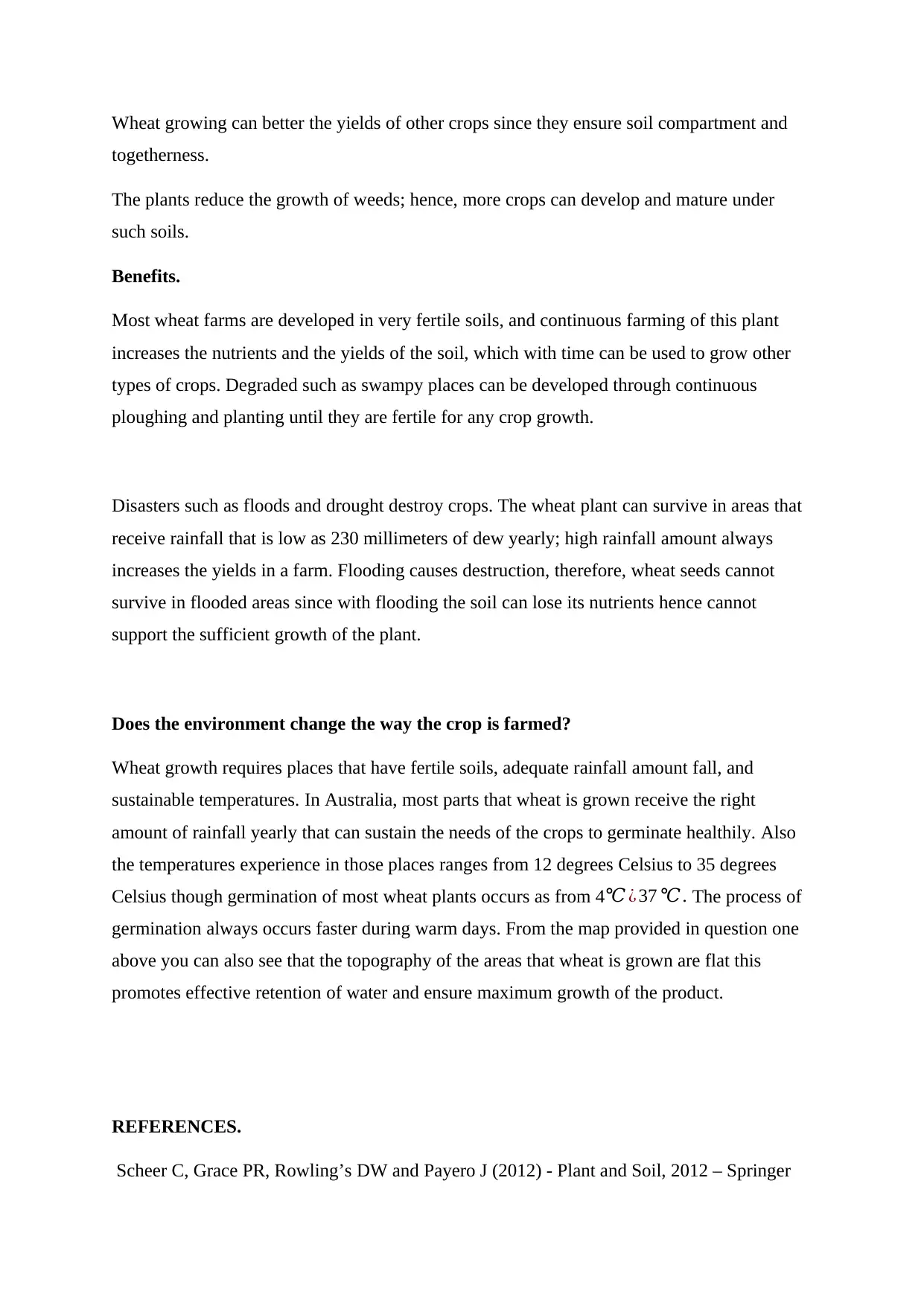
Wheat growing can better the yields of other crops since they ensure soil compartment and
togetherness.
The plants reduce the growth of weeds; hence, more crops can develop and mature under
such soils.
Benefits.
Most wheat farms are developed in very fertile soils, and continuous farming of this plant
increases the nutrients and the yields of the soil, which with time can be used to grow other
types of crops. Degraded such as swampy places can be developed through continuous
ploughing and planting until they are fertile for any crop growth.
Disasters such as floods and drought destroy crops. The wheat plant can survive in areas that
receive rainfall that is low as 230 millimeters of dew yearly; high rainfall amount always
increases the yields in a farm. Flooding causes destruction, therefore, wheat seeds cannot
survive in flooded areas since with flooding the soil can lose its nutrients hence cannot
support the sufficient growth of the plant.
Does the environment change the way the crop is farmed?
Wheat growth requires places that have fertile soils, adequate rainfall amount fall, and
sustainable temperatures. In Australia, most parts that wheat is grown receive the right
amount of rainfall yearly that can sustain the needs of the crops to germinate healthily. Also
the temperatures experience in those places ranges from 12 degrees Celsius to 35 degrees
Celsius though germination of most wheat plants occurs as from 4℃ ¿ 37 ℃ . The process of
germination always occurs faster during warm days. From the map provided in question one
above you can also see that the topography of the areas that wheat is grown are flat this
promotes effective retention of water and ensure maximum growth of the product.
REFERENCES.
Scheer C, Grace PR, Rowling’s DW and Payero J (2012) - Plant and Soil, 2012 – Springer
togetherness.
The plants reduce the growth of weeds; hence, more crops can develop and mature under
such soils.
Benefits.
Most wheat farms are developed in very fertile soils, and continuous farming of this plant
increases the nutrients and the yields of the soil, which with time can be used to grow other
types of crops. Degraded such as swampy places can be developed through continuous
ploughing and planting until they are fertile for any crop growth.
Disasters such as floods and drought destroy crops. The wheat plant can survive in areas that
receive rainfall that is low as 230 millimeters of dew yearly; high rainfall amount always
increases the yields in a farm. Flooding causes destruction, therefore, wheat seeds cannot
survive in flooded areas since with flooding the soil can lose its nutrients hence cannot
support the sufficient growth of the plant.
Does the environment change the way the crop is farmed?
Wheat growth requires places that have fertile soils, adequate rainfall amount fall, and
sustainable temperatures. In Australia, most parts that wheat is grown receive the right
amount of rainfall yearly that can sustain the needs of the crops to germinate healthily. Also
the temperatures experience in those places ranges from 12 degrees Celsius to 35 degrees
Celsius though germination of most wheat plants occurs as from 4℃ ¿ 37 ℃ . The process of
germination always occurs faster during warm days. From the map provided in question one
above you can also see that the topography of the areas that wheat is grown are flat this
promotes effective retention of water and ensure maximum growth of the product.
REFERENCES.
Scheer C, Grace PR, Rowling’s DW and Payero J (2012) - Plant and Soil, 2012 – Springer
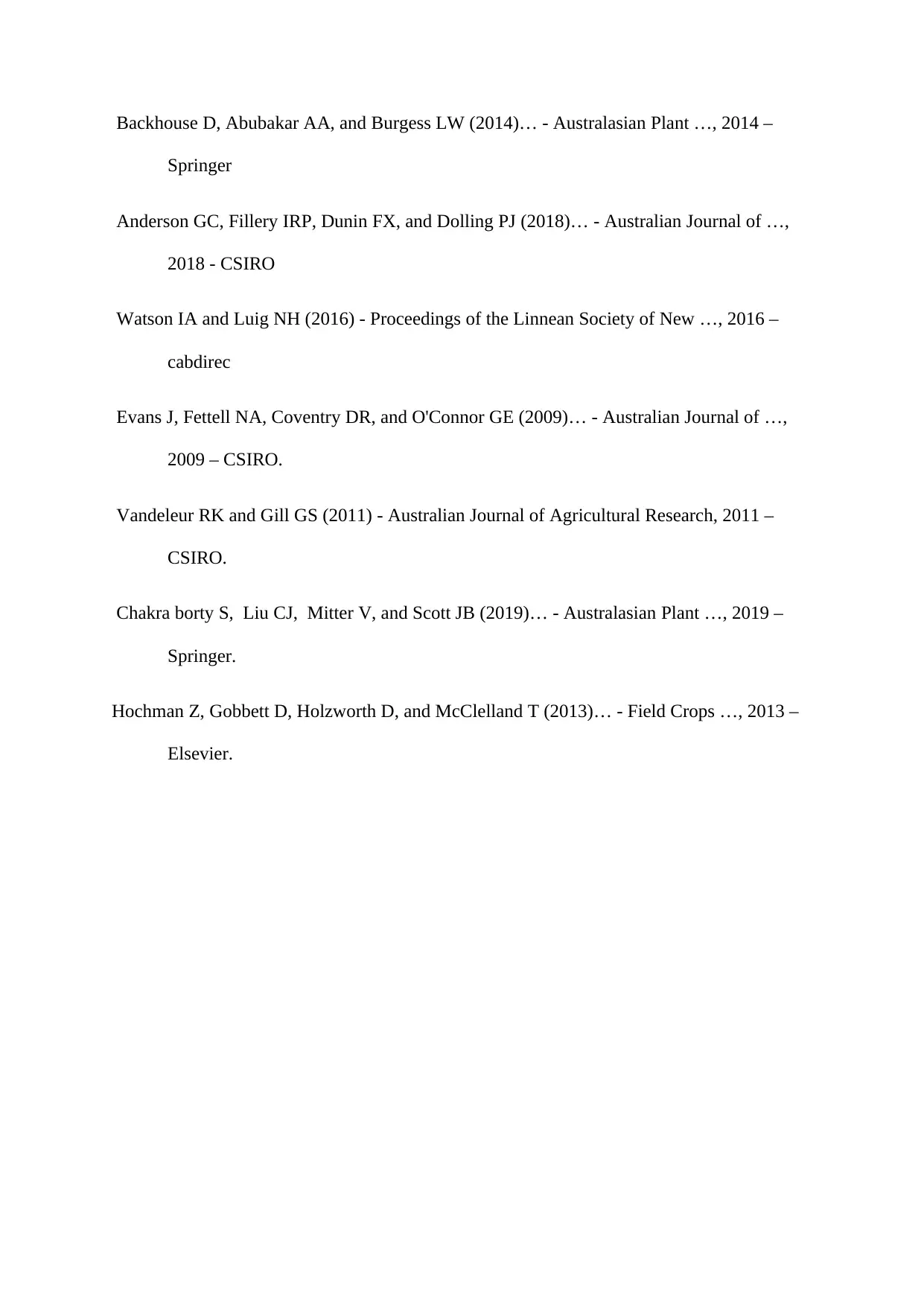
Backhouse D, Abubakar AA, and Burgess LW (2014)… - Australasian Plant …, 2014 –
Springer
Anderson GC, Fillery IRP, Dunin FX, and Dolling PJ (2018)… - Australian Journal of …,
2018 - CSIRO
Watson IA and Luig NH (2016) - Proceedings of the Linnean Society of New …, 2016 –
cabdirec
Evans J, Fettell NA, Coventry DR, and O'Connor GE (2009)… - Australian Journal of …,
2009 – CSIRO.
Vandeleur RK and Gill GS (2011) - Australian Journal of Agricultural Research, 2011 –
CSIRO.
Chakra borty S, Liu CJ, Mitter V, and Scott JB (2019)… - Australasian Plant …, 2019 –
Springer.
Hochman Z, Gobbett D, Holzworth D, and McClelland T (2013)… - Field Crops …, 2013 –
Elsevier.
Springer
Anderson GC, Fillery IRP, Dunin FX, and Dolling PJ (2018)… - Australian Journal of …,
2018 - CSIRO
Watson IA and Luig NH (2016) - Proceedings of the Linnean Society of New …, 2016 –
cabdirec
Evans J, Fettell NA, Coventry DR, and O'Connor GE (2009)… - Australian Journal of …,
2009 – CSIRO.
Vandeleur RK and Gill GS (2011) - Australian Journal of Agricultural Research, 2011 –
CSIRO.
Chakra borty S, Liu CJ, Mitter V, and Scott JB (2019)… - Australasian Plant …, 2019 –
Springer.
Hochman Z, Gobbett D, Holzworth D, and McClelland T (2013)… - Field Crops …, 2013 –
Elsevier.
⊘ This is a preview!⊘
Do you want full access?
Subscribe today to unlock all pages.

Trusted by 1+ million students worldwide
1 out of 6
Your All-in-One AI-Powered Toolkit for Academic Success.
+13062052269
info@desklib.com
Available 24*7 on WhatsApp / Email
![[object Object]](/_next/static/media/star-bottom.7253800d.svg)
Unlock your academic potential
Copyright © 2020–2025 A2Z Services. All Rights Reserved. Developed and managed by ZUCOL.


